How Will Technology And Innovation Help Build Better Social Housing?

At Quadrant’s first Smart Housing event, which was held in Birmingham, industry leaders discussed how technology and innovation are essential for net-zero, retrofitting and improving our housing stock. Housing Industry Leaders highlights the key takeaways from the panel discussion.
The panel discussion allowed the audience to interact with industry leaders from the housing sector. First, Alex Parker, Regional Specifications Manager at Aico, delivered a presentation.
Next, for the panel discussion Alex Parker was joined by Paul Jordan, Innovation Support Lead at Energy Systems Catapult and David Kemp, Associate Director at Turner & Townsend, to discuss technology and innovation in the intelligent housing sector.
For several years, the social housing sector has discussed the use of smart technology and its benefits. However, outlined in The Internet of Things and Smart Heat Controls in Social Housing: Market intelligence report 2020, it was revealed that only 56 per cent of the social housing organisations that were surveyed had either implemented or trialled IoT solutions.
Now, technology and innovation will lead the way in the sector builds better social housing; this was the key focus of the discussion.
5G Will Have A Positive Effect On Innovation
Starting the discussion by talking about 5G and how it will support social housing landlords to take a scalable and future-proofed approach with their IoT strategy, Alex Parker said that from Aico’s perspective, 5G won’t make much difference at all to their specific product but has a crucial role in the industry: “The data that we are dealing with is a very small amount of data, it’s just it’s not video, it’s not visual.
“It’s like a text message or an email ping, which can be done via a 2G network—same as things like traffic, and light signals, all very small amounts of data. So absolutely, just from our perspective, not much impact.
“But certainly, when you’re dealing with companies who are dealing with security or visual technology, and things that need to be live video images, then certainly the rollout of 5G should be a massive help to companies that do that, and organisations that want to adopt that technology as well.”
Paul Jordan was optimistic about the effect 5G is going to have on innovation, stating that it is going to open up a lot of new opportunities for the housing industry: “Having something like 5G where you can move much closer to real-time does allow much faster response on certain things.
“For instance, if you turn something off in the home, you can aggregate that quickly and that can help manage the local energy system.
Then 5G can allow those rapid responses and reactions on the system potentially, but there are lots of other potential things that 5G can open up as well.
David Kemp expressed that: “It doesn’t matter what the G is, as long as it’s not able to be unplugged. It’s not dependent on our householder’s or a tenant’s or resident’s Wi-Fi broadband connection. That’s where the real benefit lies in this, as well as technology.”
He continued to speak about the technologies that are being put into properties now, such as batteries and heat pumps. For these technologies to work effectively, they need to be turned on and off quickly: “If 2G is just too slow, like that modem, that’s going to have limited factors on the revenue that can generate for you as landlords but equally, a few of those segments that the tenants and residents can benefit from.”
Tackling Barriers Is Key For Social Housing
There are many barriers when it comes to scaling up the use of technology and innovation in social housing. Tackling these barriers is essential if the housing industry is to improve its housing stock.
Alex explained that when it comes to scaling up, the first barrier is cost: “We have experienced the housing associations which have money in the bank, and we have experienced the local councils of 1000 properties, who are on the verge of bankruptcy in some instances.
Cost can always be a challenge to scaling up. So, we need to find ways of making that not as much of a barrier.
To Alex, other barriers include education and priorities. With these in place and the sufficient funding available, he said that he believes this will help to address the issues that social housing currently faces.
David added that it is important to understand the benefit of the particular piece of kit: “If we can articulate the benefit and if we recognise that the total cost of acquisition of this piece of kit is beneficial to the landlord organisation. It is more about the financing thing, rather than the actual capital cost itself.”
As the conversation continued, the message was clear. Though the housing sector has come a long way in the last decade and is currently seeing technology and innovation providing many benefits, there is still a long way to go.

